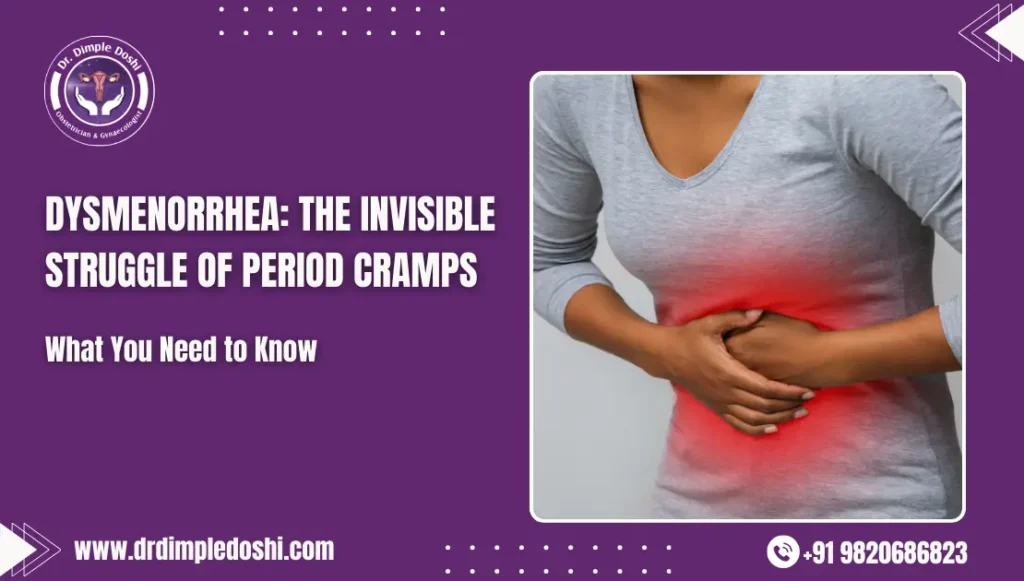Dysmenorrhea: The Invisible Struggle of Period Cramps

Table of Contents
Dysmenorrhea, or period cramps, is an invisible condition that is often overlooked by families, dismissed in medical settings, and endured in silence by those who suffer from it. Unlike visible ailments like broken bones, fever, or diarrhea, dysmenorrhea has no outward symptoms, making it easy for others to underestimate the pain and fatigue women experience.
Understanding Period Cramps
Primary vs. Secondary Dysmenorrhea
Period cramps affect a significant number of women. Around 50% to 95% of women experience primary dysmenorrhea, which occurs without any underlying condition. Meanwhile, 10% to 15% suffer from secondary dysmenorrhea due to diseases like endometriosis and fibroids.
Types of Period Pain
1. Primary Dysmenorrhea
- Caused by natural contractions of the uterus due to prostaglandins (hormone-like substances).
- Begins at the onset of periods and may last 1 to 2 days.
- Usually mild to moderate and responds well to painkillers.
2. Secondary Dysmenorrhea
- Caused by underlying medical conditions.
- Pain starts earlier in the cycle and lasts longer than usual period cramps.
- Can be debilitating, restricting women from performing daily tasks.
- Often requires heavy doses of painkillers to manage the first 3 to 4 days of menstruation.
- Common causes:
- Endometriosis (uterine-like tissue grows outside the uterus)
- Adenomyosis (uterine lining grows into the muscle wall)
- Fibroids (noncancerous growths in the uterus)
- Pelvic Inflammatory Disease (PID) (infection in reproductive organs)
- Ovarian Cysts
Dysmenorrhea Treatment
1. Medications
- Pain relievers (NSAIDs): Ibuprofen (Brufen), Mefenamic Acid (Meftal-Spas), or Naproxen help reduce pain and inflammation.
- Antispasmodics: Drotaverine (Drotin) or Hyoscine (Buscopan) relieve cramps.
- Hormonal treatments: Birth control pills or hormonal patches help regulate periods and minimize pain.
2. Home Remedies
- Heat therapy: Applying a heating pad or warm water bottle on the lower abdomen relaxes muscles and improves blood flow.
- Massage: Gently massaging the lower abdomen with essential oils like lavender or clove oil may relieve cramps.
- Hydration: Drinking warm fluids like herbal teas or hot water can reduce bloating and pain.
- Exercise & stretching: Light activities such as walking, yoga, or stretching release endorphins, which act as natural pain relievers.
3. Lifestyle Changes
- Dietary modifications: Reduce caffeine, alcohol, and salty foods while increasing magnesium-rich foods (bananas, nuts) and omega-3s (flaxseeds, fish).
- Stress management: Meditation, deep breathing, or acupuncture may help alleviate pain.
- Regular exercise: Maintaining an active lifestyle throughout the month can lead to less severe cramps.
Advanced Treatment Options
- Laparoscopy: If pain is due to conditions like endometriosis, fibroids, or adhesions, minimally invasive surgery may be necessary.
When to See a Doctor
Seek medical help if:
- Period pain is severe and lasts more than 2-3 days.
- Accompanied by heavy bleeding, nausea, or irregular cycles.
- There is suspicion of underlying conditions like endometriosis or fibroids.
Conclusion
Dysmenorrhea is a serious condition that affects millions of women. It is crucial to acknowledge the pain, seek appropriate treatment, and spread awareness to ensure that women suffering from period cramps receive the care and support they deserve.
